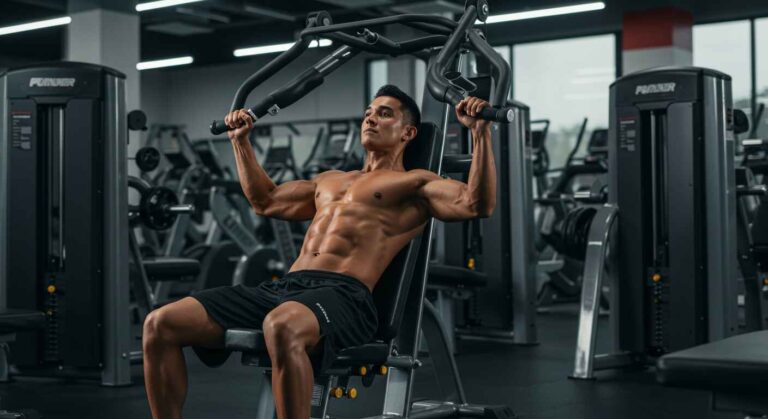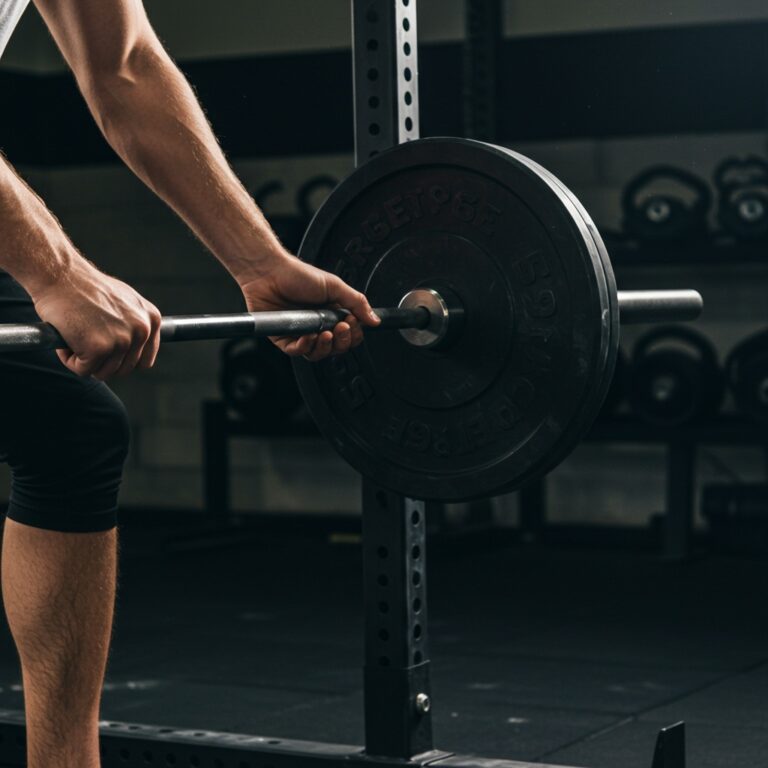Stuck at a lifting plateau? Dealing with shoulder pain from years of pressing?
You’re not alone. Many lifters hit walls with standard barbells. The solution might be a uniquely designed tool that looks unusual but delivers powerful results: the cambered bar.
This specialty barbell increases your range of motion, challenges your stability, and builds raw strength in ways a straight bar simply can’t.
Whether you want a bigger bench press, stronger squat, or healthier shoulders, this specialty bar could be your game-changer.
Quick Answer: What Is a Cambered Bar?
A specialty barbell with a distinct bend in its center. This design lowers the weight plates relative to your hands.
Key Benefits:
- Increases range of motion during lifts
- Enhances muscle stretch and activation
- Forces stabilizer muscles to work harder
- Often more joint-friendly than straight bars
The deeper range of motion creates superior muscle growth while building functional strength.
What Exactly Is a Cambered Bar?
At first glance, a cambered bar looks like a bent barbell. But this unique shape is intentional and highly functional.
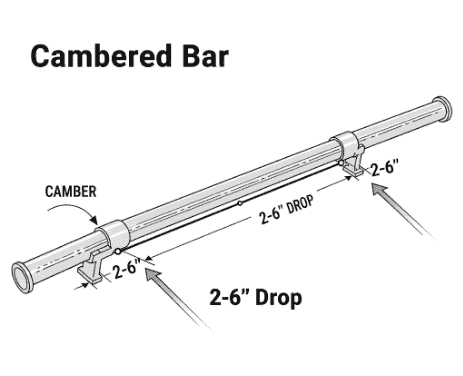
The Unique Design: Unpacking the “Camber”
The defining feature is the camber itself—a 2 to 6-inch drop in the center where you grip. The weight sleeves remain at the original height.
When you bench press, this drop lets you lower the bar further onto your chest than a straight bar allows. For squats, it changes your center of gravity.
This simple change creates:
- Increased Stretch: Forces deeper stretch at the bottom of movements
- Instability Challenge: Weight swings slightly, engaging more stabilizer muscles
- Novel Stimulus: Provides new challenges to break through plateaus
Most cambered bars use Olympic compatibility (2-inch sleeves) and feature knurled grips for secure handling.
How Much Does a Cambered Bar We
Common Question: How much does a cambered bar weigh?
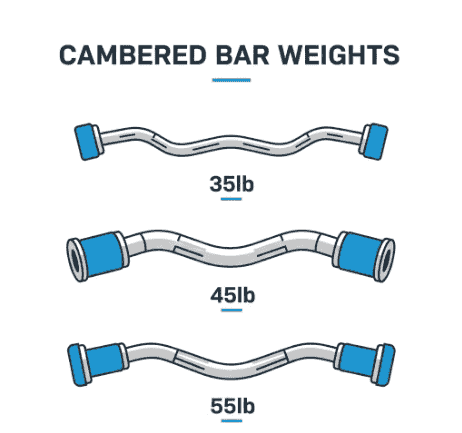
Unlike standardized Olympic barbells (45 lbs), cambered bar weights vary:
- Light Models: 35-40 pounds
- Standard Models: 45-50 pounds
- Heavy-Duty Models: 55+ pounds (for elite lifters)
- Length: Usually 7 feet (fits standard racks)
Always check your specific bar’s weight before loading plates.
Unlocking New Gains: Top 5 Benefits of Training
1. Deeper Range of Motion = Better Muscle Growth
This is the #1 reason lifters choose this specialty equipment.
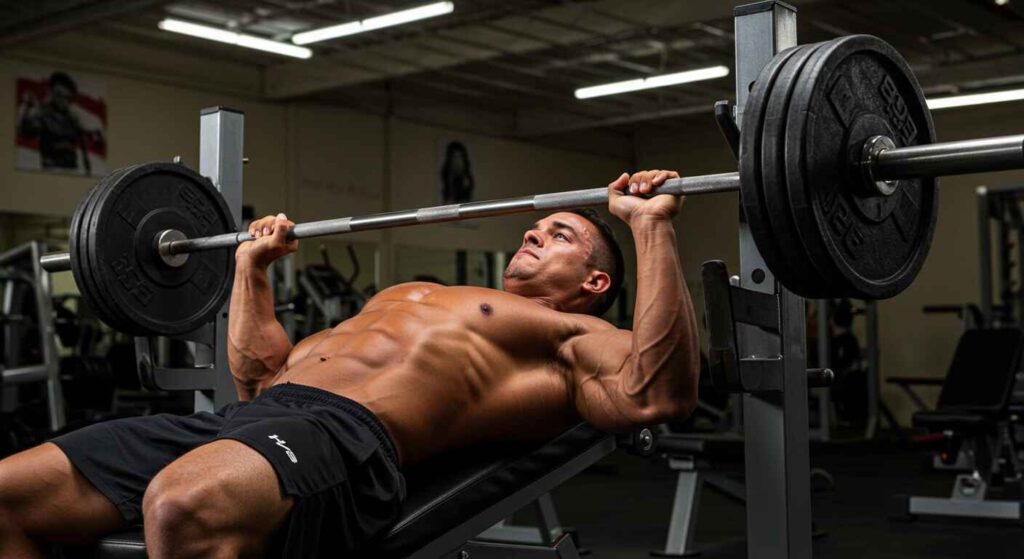
During pressing movements, the bar travels several inches lower than normal. This creates incredible stretch on your chest muscles.
The Science: Training muscles in their fully lengthened position leads to superior growth. This “stretch-mediated hypertrophy” signals your body to build back bigger and stronger.
2. Shoulder-Friendly Alternative
Many lifters suffer shoulder pain from standard bench pressing. This specialty equipment can be surprisingly shoulder-friendly.
How it helps:
- Strengthens Stabilizers: Forces small rotator cuff muscles to fire and strengthen
- Improves Technique: Punishes poor form, teaching better movement patterns
- Natural Movement: Allows more natural pressing angles
Pro Tip: If you have shoulder issues, start with an empty bar and focus on slow, controlled movements.
3. Builds Posterior Chain Strength
This equipment excels for posterior chain training (glutes, hamstrings, lower back).
During squats or good mornings, the lower center of gravity pulls you forward. Your entire posterior chain must work overtime to keep you upright.
Benefits include:
- Enhanced glute and hamstring activation
- Stronger lower and upper back
- Better squat and deadlift carryover
4. Breaks Through Plateaus
Stuck at the same weights for months? The cambered bar provides a novel stimulus your muscles haven’t adapted to.
The instability and deeper range challenge your nervous system in new ways. This often translates to improved performance with regular barbells.
5. Reduces Wrist Strain
Some lifters find the slight angle modifications more comfortable than straight bars.
For ultimate wrist comfort, multi-grip cambered bars (Swiss-style) offer neutral grip positions—the gold standard for joint-friendly pressing.
Essential Cambered Bar Exercises
Cambered Bar Bench Press: Build a Bigger Chest
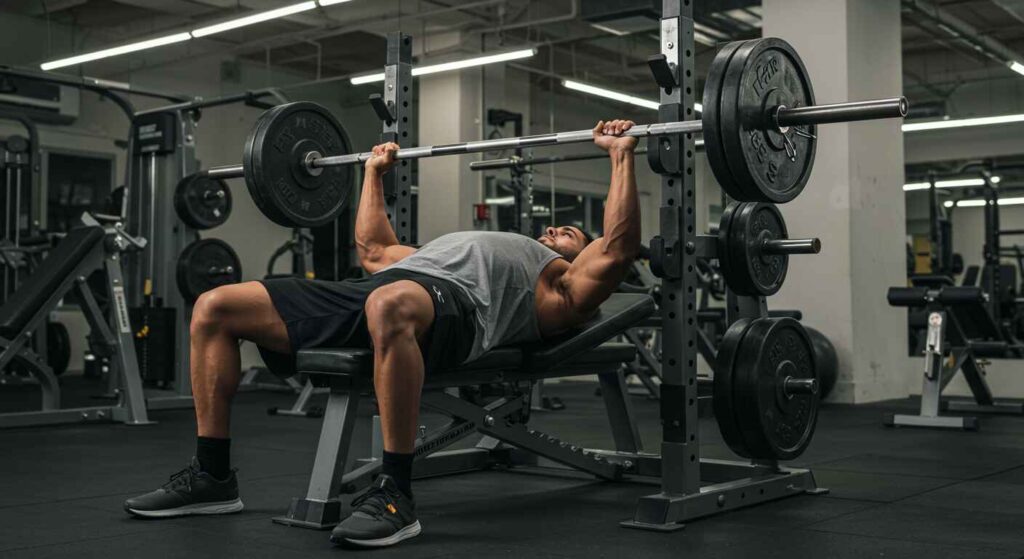
This is the signature movement. The cambered bar bench press is an incredible chest-building exercise.
Setup Instructions:
- Safety First: Set power rack pins just below your chest at the bottom position
- Grip: Use your normal bench press grip width
- Positioning: Unrack and stabilize the bar over your chest
Movement Execution:
- Descent: Lower slowly and controlled—focus on “pulling” the bar down with your lats
- Bottom Position: Touch chest and feel the deep pectoral stretch
- Press: Drive powerfully off your chest, engaging pecs and triceps
- Control: Keep core tight to manage the bar’s natural sway
Starting Weight: Use 50-60% of your normal bench press weight initially. If you’re unsure of your max, use a one rep max calculator to determine your baseline before beginning cambered bar training.
Cambered Bar Squat: Posterior Power Builder
The cambered bar squat is humbling but highly effective for powerlifters and strength athletes.
If you experience knee pain during squats, the cambered bar’s altered center of gravity may actually help by reducing forward knee travel.
Setup:
- Position bar on your back like a standard squat
- The weight hangs lower and pulls you forward
- Take your normal squat stance
Execution:
- Descent: Break at hips, sit back while fighting to keep chest up
- Bottom: Maintain tight back—the bar punishes forward lean
- Ascent: Drive up leading with head and chest, squeeze glutes at top
This exercise builds incredible strength out of the squat bottom and develops rock-solid upper back stability.
Cambered Bar Accessory Movements
Seal Rows:
- Lie face-down on high bench
- Row the cambered bar for greater range of motion
- Intense lat and rhomboid peak contraction
Good Mornings:
- Advanced posterior chain builder
- Targets hamstrings, glutes, and lower back
- The camber increases difficulty and effectiveness
Overhead Press:
- Demands incredible shoulder and core stability
- Great for building pressing strength and control
Types of Cambered Bars: Choose Your Weapon
Standard Cambered Bar
Features:
- 2-4 inch camber depth
- 35-45 pound weight range
- Designed primarily for bench pressing
- Perfect for most home and commercial gyms
Heavy-Duty Cambered Squat Bar
Features:
- 5+ inch camber depth
- 45-65 pound weight range
- Thicker, more robust construction
- Preferred by powerlifters for squat training
Multi-Grip Cambered Bar (Swiss Style)
Features:
- Combines camber with multiple handle positions
- Neutral and angled grip options
- Ultimate shoulder-friendly design
- Best for lifters with joint issues
Popular Models:
- Rogue CB-1 Camber Bar (industry standard)
- EliteFTS varieties
- Rep Fitness options
Cambered Bar Training Guidelines
Start Smart: Beginner Protocol
Week 1-2:
- Use empty bar only
- Focus on 3-4 second negatives
- Master the movement pattern
- 3 sets of 8-12 reps
Week 3-4:
- Add light weight (25-50% normal load)
- Maintain slow, controlled reps
- Build confidence and stability
Safety Requirements
Before incorporating cambered bars into your routine, it’s crucial to test your 1RM safely with regular barbells to establish baseline strength levels.
Non-Negotiables:
- Always use a power rack with safety pins
- Set pins just below lowest bar position
- Never train alone with cambered bars
- Warm up thoroughly before each session
Programming Integration
When programming cambered bar work, use appropriate 1RM percentages for training to ensure optimal stimulus without overreaching.
Option 1: Plateau Buster (3-4 weeks)
- Replace main lift with cambered variation
- Focus on building strength in new range
- Return to regular bar with improved performance
Option 2: Accessory Work
- Use after main lifts
- 2-3 sets of 6-10 reps
- Focus on muscle building and stability
Option 3: Conjugate Method
- Rotate every 1-3 weeks
- Pair with regular barbell training
- Build well-rounded strength
Common Mistakes to Avoid
Going Too Heavy, Too Soon
The Problem: Most lifters use too much weight initially. The Solution: Start with 50% of your regular weight and build gradually.
Losing Tightness at Bottom
The Problem: The deep range causes lifters to lose form. The Solution: Maintain arch and shoulder blade retraction throughout.
Sacrificing Form for Range
The Problem: Reaching for extra depth with poor positioning. The Solution: Control the movement—don’t just let gravity take over.
Neglecting Regular Barbells
The Problem: Exclusively using cambered bars hurts regular bar performance. The Solution: Use cambered bars as a supplement, not replacement.
Quick Reference: Cambered Bar FAQs
How much does a cambered bar weigh?
Weight varies by model: 35-65 pounds typically. Always check your specific bar’s weight.
Is a cambered bar better than regular barbells?
It’s different, not better. Regular bars test absolute strength. Cambered bars build strength in weak ranges and provide training variety.
Can beginners use cambered bars?
Beginners should master basic movements first. Intermediate lifters with solid form can benefit greatly.
What’s the main cambered bar benefit?
Increased range of motion creates deeper muscle stretch, leading to enhanced growth and strength gains.
How often should I use a cambered bar?
Use for 3-4 week training blocks or as accessory work 1-2 times per week.
Cambered Bar Comparison Chart
| Feature | Cambered Bar | Regular Barbell |
|---|---|---|
| Range of Motion | Extended | Standard |
| Stability Challenge | High | Low |
| Learning Curve | Moderate | Easy |
| Joint Stress | Often Lower | Variable |
| Muscle Activation | Enhanced | Standard |
| Competition Use | No | Yes |
| Versatility | High | Highest |
Getting Started: Your Action Plan
Phase 1: Assessment (Week 1)
- Evaluate current lifting experience
- Check for any shoulder/joint issues
- Research cambered bar options
- Find a gym with cambered bars or purchase one
Phase 2: Introduction (Weeks 2-3)
- Start with empty bar
- Master movement patterns
- Focus on form over weight
- Build confidence gradually
Phase 3: Integration (Weeks 4-6)
- Add appropriate weight
- Include in regular programming
- Track progress and adaptations
- Adjust based on response
Phase 4: Optimization (Ongoing)
- Cycle in and out of programs
- Use for specific weaknesses
- Maintain regular barbell proficiency
- Continue progressive overload
Final Verdict: Transform Your Training
The cambered bar isn’t just another gym gadget—it’s a proven tool for serious lifters.
Perfect for:
- Breaking through strength plateaus
- Building muscle with deeper range of motion
- Improving shoulder health and stability
- Adding training variety and challenge
Key Success Factors:
- Start light and focus on form
- Use proper safety equipment
- Integrate strategically with regular training
- Be patient with the learning curve
Ready to take your training to the next level? The cambered bar might be the tool that finally breaks through your current limitations.
Whether you’re a powerlifter chasing PRs or a bodybuilder seeking new growth, this bent piece of steel offers unique advantages no straight bar can match.
Take Action: Find a gym with cambered bars or invest in one for your home setup. Your future stronger self will thank you.
Remember: Always consult with a qualified trainer when introducing new equipment. Start light, focus on form, and prioritize safety above all else.

